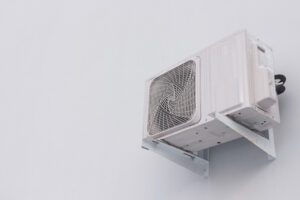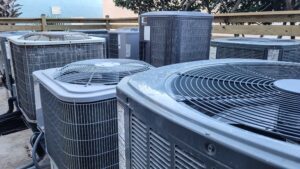Introduction to Heating Solutions for Winter
Keeping your home warm during winter doesn’t mean you have to stick with old-fashioned radiators or crank up the central heating and face sky-high bills. There are innovative heating solutions that can make your living space cozy, efficient, and kind to your wallet. From smart thermostats that let you control your home’s temperature from your phone to eco-friendly options that use renewable resources, the options are vast. Imagine walking on warm floors heated by beneath-the-surface systems or enjoying the ambient heat of a modern, efficient fireplace that complements your decor. We’ll discuss solutions that leverage the latest technology and sustainable practices, aiming for comfort without compromise. Understanding your options is the first step to a warmer home this winter.
Smart Thermostats: Energy Efficiency and Comfort
Smart thermostats are not just gadgets; they are game-changers in heating your home. Here’s why: they learn your schedule. Yes, that’s right. They adjust your home’s heating based on when you’re there and when you’re not. This means while you are at work or running errands, your thermostat smartly reduces heating, saving energy and, importantly, your money. And when you’re about to come home? It ramps up the heat so you step into a warm, welcoming space. The best part is you can control these devices from your smartphone. Whether you’re on your couch or out shopping, you can adjust your home’s temperature with a few taps. Energy efficiency and comfort aren’t mutually exclusive. With smart thermostats, they go hand in hand. Imagine cutting your energy bill without sacrificing warmth. That’s not just smart; it’s genius.
Solar Heating Systems: Harnessing the Sun’s Power
Solar heating systems tap into the sun’s abundant energy, making them a smart choice for keeping your home cozy without hiking up your utility bills. These systems work by converting sunlight into heat through solar panels installed on your roof. The warmth is then transferred inside to raise your home’s temperature, all while using zero fossil fuels. This approach not only slashes your heating costs but also benefits the planet by reducing carbon emissions. Although the initial setup cost can be steep, ranging from a few thousand to over ten thousand dollars, the long-term savings on your energy bills make solar heating a wise investment. Plus, many regions offer incentives or rebates for solar energy installations, making it even more accessible. Embracing solar heating means you’re choosing a sustainable and cost-effective way to stay warm during the cold months.
Geothermal Heating: The Underground Solution
Under your feet, the Earth holds a secret to keeping your home warm without relying heavily on traditional heating methods. Geothermal heating taps into the underground temperatures to heat your home during the cold winter months, providing a sustainable and energy-efficient solution. It works by installing a series of pipes, known as a geothermal loop, beneath the ground. These pipes circulate water that absorbs the Earth’s constant underground temperature, roughly about 55°F, and then a heat pump in your home uses this temperature-regulated water to warm your space. The initial setup might sound pricey, but think of it this way: geothermal systems cut down heating costs by 30% to 60% compared to conventional systems. Plus, they’re kinder to the planet. So, while the upfront investment is higher, the savings and environmental benefits make geothermal heating a hot choice for the future. It’s an underground solution that brings warm benefits to your doorstep.
Portable Heaters: Flexibility and Convenience
Portable heaters pack a punch when it comes to warming up a space quickly and efficiently. Their biggest perks? Flexibility and convenience. You can move them from room to room, targeting the chill exactly where it’s needed most. No need to heat up the whole house if you’re just working away in your home office or curled up reading in the living room. They come in various types—electric, oil-filled, infrared, and ceramic—each with its strengths. Electric heaters warm up swiftly, making them perfect for quick heat. The oil-filled ones take a bit longer but keep the room warm for longer. Infrared heaters target specific objects and surfaces, warming them directly, while ceramic heaters distribute heat more evenly. Plus, they’re a budget-friendly option. No hefty installations or long-term commitments. Just plug in, and you’re good to go. Whether you’re dealing with a cold snap or your central heating just isn’t cutting it, a portable heater can be your go-to solution for staying toasty.
Hybrid Heating Systems: The Best of Both Worlds
Hybrid heating systems combine the strength of gas furnaces with the efficiency of heat pumps to give you a powerhouse of warmth during winter. Think of it as having the best of both worlds; when it’s mildly cold, the heat pump efficiently pulls heat from the outside air, using less energy. Colder days? The system switches gears to the gas furnace, pumping out all the heat you need without breaking a sweat. This switch happens automatically, making sure you’re always using the most cost-effective option to stay warm. Because of this, hybrid systems can significantly lower your monthly energy bills. Plus, they’re eco-friendlier. By using electricity most of the time and gas only when absolutely necessary, you reduce your carbon footprint. So, you’re not just saving money, you’re also doing your bit for the planet.
The Advantages of Modern Heating Solutions
Modern heating solutions are more than just warm air; they bring a bunch of perks to the table you might not have thought about. First up, they’re efficient. We’re talking about using less energy to get more heat. This means lower utility bills every month and who doesn’t like saving money? Next, they’re cleaner for the environment. Less energy use equals less pollution, so you’re doing your part to keep the planet green. Also, these systems are often smarter. Many come with the ability to control them from your smartphone, so you can get your home warm before even stepping through the door. Plus, they’re less noisy. Forget the clunks and bangs of old heaters; these new models whisper. Lastly, they’re designed to last longer, giving you more bang for your buck over the years. So, with modern heating solutions, you’re looking at saving money, easing your conscience, enjoying convenience, peace and quiet, and investing in longevity.
Considerations Before Choosing Your Heating Solution
Before jumping into buying a heating solution, think it over carefully. Not all heaters suit every home. First, evaluate the size of your space. A small heater won’t do much in a large room, and a big one in a small space is overkill. Efficiency matters too. Look for heaters that don’t jack up your electricity bill sky-high. Think about the type of heater. Some use oil, others electricity, and some can even run on solar power. Installation can be a hassle and expensive for certain types. Noise is another factor. You don’t want a heater that sounds like a jet taking off. Lastly, consider safety features, especially if you’ve got kids or pets around. Opt for heaters with automatic shut-off or tip-over protection. Choosing wisely saves you from headaches and chilly nights later.
Installation Tips and Tricks for Homeowners
When it comes to installing innovative heating solutions in your home, there’s no need to break into a cold sweat. First off, let’s get this straight: most of these systems are more about planning than hard labor. Before diving into installation, consider the layout of your home. You want your new heating system to work efficiently, so place it where it’ll spread warmth without obstacles. For radiant floor heating, that means thinking about where you spend most of your time standing or walking. It’s not just about laying pipes or cables; it’s about making your mornings in the kitchen or bathroom a toastier affair.
Now, if you’re looking at something a bit high-tech, like a smart thermostat for your existing heating system, pairing is pretty straightforward. Just follow the manufacturer’s guide to connect it with your home Wi-Fi. It allows you to control your home’s temperature from anywhere, ensuring you walk into a cozy house without wasting energy heating an empty space.
And here’s a pro tip: insulation isn’t just a buzzword. It’s the secret ingredient to keeping your home warm without cranking up the heat 24⁄7. Before you even think about new heating systems, check your home’s insulation. Good insulation can make or break the efficiency of your innovative heating solution.
Lastly, don’t shy away from professional help for the more complex systems, especially those that require electrical or plumbing changes, like underfloor heating or a high-efficiency furnace. The upfront cost of installation might make you wince, but remember, a correctly installed system works more efficiently and saves money in the long run.
So, gear up, plan, and maybe even learn a thing or two about thermostats. With a bit of know-how and the right approach, you can keep your home snug as a bug this winter.
Conclusion: Preparing for a Warm and Cozy Winter
Getting your home ready for a warm and cozy winter doesn’t have to be complex or expensive. With the innovative heating solutions we’ve talked about, like smart thermostats, solar heating systems, efficient fireplaces, underfloor heating, and heat pumps, you’re now equipped with knowledge to make an informed decision. Remember, the key is to choose a heating solution that not only meets your immediate needs but is also efficient and sustainable in the long run. Whether you’re leaning towards the eco-friendly appeal of solar heating or the consistent warmth of underfloor heating, planning ahead can save you money and keep you comfortable all winter long. Stay warm!




